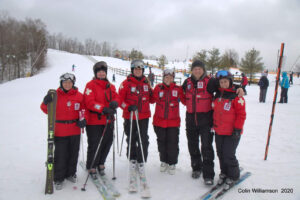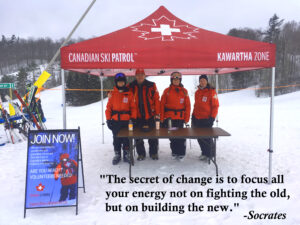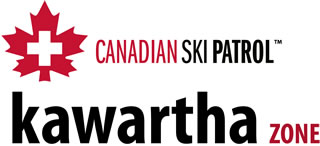The motto for the Canadian Ski Patrol is Safety and Service. Since its inception more than 60 years ago, the CSP has had as its primary mission the prevention of injuries and the provision of first aid in cases of injury or sudden illness. In the past few years, the snow sports industry had turned more and more to the CSP as the front line of promotion of injury prevention and safety, because we are highly visible, present on the majority of trails and looked up to by skiers, boarders and the public in general. CSP members promote safety in three key ways:
- By setting an example through their own actions;
- By educating skiers through talks, presentations and discussions, and
- By on-snow actions both in regard to the conditions and in dealing with dangerous or hazardous skiers.
PATROLLING SAFETY TIPS
Safety on those snow sliding boards – double or single – starts well before you get to near the white powdery stuff. The season has started, and even if you have had a few runs already, it is still time to give ALL your equipment a check over.
Start with you. Clothes, undergarments to Ski Jacket. Gloves, hat or Helmet. They should all be given a close look over to make sure there are no frayed seems, bits dangling to catch on chairs etc. And Clean.
Boots and Boards. Make sure they are cleaned, bindings properly set and working as they were designed to. A quick tuning at the Hill’s ski shop will do wonders to your style – and comfort.
I know you know all this. We all do. And that is precisely why we need to be reminded. That old saying “Familiarity Breeds Contempt” is all too true when applied to serious sports equipment and your safety. So have a humble fit, and do check it all out.
Safety on the hill starts with you…
NO “ACCIDENTS”
“Accident” is a term used to absolve responsibility. How many drivers say: “I had an accident because of the weather.” That’s a real cop out. Blame the weather – not the fact that they were driving too fast for the conditions, their car was not properly equipped for winter driving with proper winter tires, they didn’t check the road surface for icy patches, their defrosters weren’t working properly causing impaired vision, they just didn’t know how to drive in winter, etc.
Airplanes don’t have “accidents” – they crash, and the reason for those crashes usually include human error, or mechanical failure – and the various authorities work very hard to determine those causes for future reference. Bad weather doesn’t cause crashes, but not responding adequately to it, or making wrong judgment moves, does.
The same goes for winter sports. Skiers and Snow Boarders don’t have accidents. They crash – due to poor judgment, skiing or boarding beyond their capabilities, not looking where they are going or checking for up-hill skiers when entering trails or changing directions, skiing out-of-bounds, etc.
Accident is a word that should not be part of a Ski Patrollers vocabulary – or anybody’s. Always look for the cause, and sometimes that could point to a solution for an unforeseen problem. Yes, we have “Incidents” on the hills, often causing bodily harm which we are called upon to respond to with out training, and that is a valid term, often caused by a skier or border “crashing”. There is a cause, which you must become aware of so you can properly report that incident.
Incident – Not Accident. Erase that “A” word from your vocabulary – when Patrolling – or anytime. It is amazing what you will learn, and knowing those causes, and acting accordingly, could perhaps sometime save you from serious injury – or even save your life.
ON HILL KID PARKING
Although we have several safety programs aimed at younger skiers and boarders, and most of them ski and board relatively responsibly, kids tend to be more focused on what they are doing and on their friends, than what is going on around them.
This is most apparent on hill when they come to a stop to wait for their friends, or just take a break and chat. They stop where they are – whether it is in the middle of the run, partially blocking passage at the top of a run, at the junction of two runs, or when they get off the chair lift. The problem is more apparent with snow boarders – not because they are different from skiers, or less aware, but because it is much easier to flop down and sit on the snow with your board on, than with skis on your feet.
The danger is that they are low on the ground, often just below a rise, where they are not very visible to approaching skiers and boarders, even though they are partially blocking the trail – or trails. Add some novice skiers and boarders who are unsteady and slow at turning and stopping, and we are building a nice scenario for next year’s practicals.
They kids just aren’t aware – so we have to keep our eyes open and point out to them the potential dangers of their position.
So here’s a hint – instead of just telling them to “move or you might get hurt” or something like that, quietly suggest to them that they should move over to the side of the run while they are talking or waiting for their friends. Why? – say you are concerned because there are some novices on the hill that are just learning to ski or board, and they can’t stop or turn too well, and they could get hurt if they collide with our stationary skiers or boarders. That way you get the kids on your side, helping you keep the hills safer for the “novices”, which implies that they are better skiers or boarders, and therefore in a better position to help. They usually move quite willingly, and quickly.
Collisions are a growing concern for on-hill safety, and this is just one way we can help defuse that problem.

